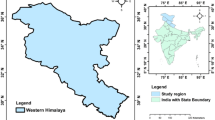Abstract
Forest fire prediction is very important for protecting forests from fire. This is a severe environmental issue that is destroying the ecosystem’s ecology. It raises the crisis of other logical disasters and depletes resources like water, contributing to global warming and pollution. The detection of fire is a critical component of incident control. Forest fire prediction is supposed to lessen the future impact of forest fire. There are many algorithms to help detect forest fires, each of which has a different approach to fire detection. The current processes anticipate the fire-affected zone based on satellite imagery, which isn’t entirely accurate. The proposed system uses weather conditions such as rain, humidity, wind, and temperature to anticipate the occurrences of forest fires. We employed multiple sub-samples of the dataset on which the RandomizedSearchCV method fitted many decision trees and also used averaging to improve the accuracy. We will explore many models for predicting forest fires in this study.
Access this chapter
Tax calculation will be finalised at checkout
Purchases are for personal use only
Similar content being viewed by others
References
Anshori M, Alauddin MW, Mahmudy WF, Mari F (2019) Prediction of forest fire using neural network based on extreme learning machines (ELM). IEEE Explore. ISBN:978-1-7281-3880-0
Wijayanto AK, Sani O, Kartika ND, Herdiyeni Y (2017) Classification model for forest fire hotspot occurrences prediction using ANFIS algorithm. In: IOP conference series: earth environment Science, vol 54, p 012059
Shenoy A, Thillaiarasu N (2022) A survey on different computer vision based human activity recognition for surveillance applications. In: 6th International conference on computing methodologies and communication (ICCMC), Erode, India, pp 1372–1376. https://doi.org/10.1109/ICCMC53470.2022.9753931
Cortez P, Morais AJR (2021) A data mining approach to predict forest fires using meteorological data
Sun Z, Fox G (2005) Study on parallel SVM based on MapReduce. In: 2021 International Conference, vol 2. IEEE, pp 1214–1 217
Yang S, Lupascu M, Meel KS (2019) Predicting forest fire using remote sensing data and machine learning meel. Int J Recent Technol Eng (IJRTE) 8(2). ISSN: 2277-3878
De M, Labdhi L, Garg B (2020) Predicting forest fire with different data mining techniques. IJSDR. ISSN: 2455-2631
Suresh Babu V (2019) Developing forest fire danger index using geo-spatial techniques. Thesis, IIT Hyderabad. Report no: IIIT/TH/2019/21
Shenoy A, Suvarna S, Rajgopal KT (2023) Online digital cheque signature verification using deep learning approach. In: 2nd International conference on edge computing and applications (ICECAA), Namakkal, India, pp 866–871. https://doi.org/10.1109/ICECAA58104.2023.10212410
Rishickesh R, Shahina A, Khan AN (2019) Predicting forest fires using supervised and ensemble machine learning algorithms. Int J Recent Technol Eng (IJRTE) 8(2). ISSN: 2277-3878
Balaji N, Karthik BPH, Bhat B, Praveen B (2021) Data visualization in splunk and Tableau: a case study demonstration. J Phys Conf Ser
Balaji N, Karthik Pai BH, Manjunath K, Venkatesh B, Bhavatarini N, Sreenidhi BK (2022) Cyberbullying in online/e-learning platforms based on social networks. In: World conference on smart trends in systems, security and sustainability—WorldS4. Springer Lecture Notes in Networks and Systems–LNNS
Santhosh S, Shenoy A, Kumar S (2023) Machine learning based ideal job role fit and career recommendation system. In: 7th International conference on computing methodologies and communication (ICCMC), Erode, India, pp 64–67. https://doi.org/10.1109/ICCMC56507.2023.10084315
Author information
Authors and Affiliations
Corresponding author
Editor information
Editors and Affiliations
Rights and permissions
Copyright information
© 2024 The Author(s), under exclusive license to Springer Nature Singapore Pte Ltd.
About this paper
Cite this paper
Bhavatarini, N., Santhosh, S., Balaji, N., Kumari, D. (2024). An Approach to Conserve Wildlife Habitat by Predicting Forest Fire Using Machine Learning Technique. In: Guru, D.S., Kumar, N.V., Javed, M. (eds) Data Analytics and Learning. ICDAL 2022. Lecture Notes in Networks and Systems, vol 779. Springer, Singapore. https://doi.org/10.1007/978-981-99-6346-1_5
Download citation
DOI: https://doi.org/10.1007/978-981-99-6346-1_5
Published:
Publisher Name: Springer, Singapore
Print ISBN: 978-981-99-6345-4
Online ISBN: 978-981-99-6346-1
eBook Packages: Intelligent Technologies and RoboticsIntelligent Technologies and Robotics (R0)




